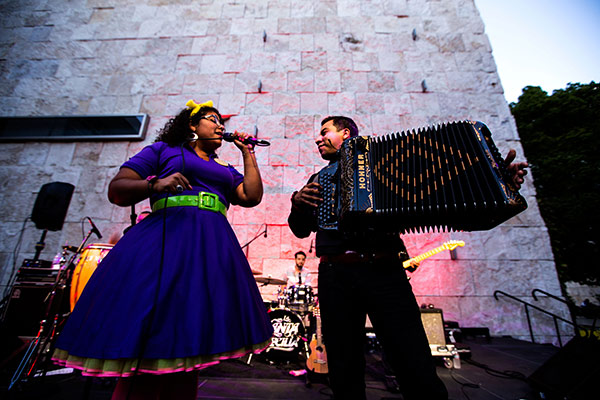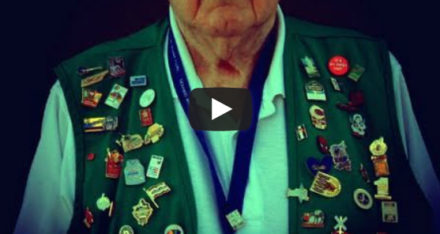In celebration of #GivingTuesday, a roundup of ideas to support the arts in creative ways

One good way to support art: make some!
![]() December 3 marks the second annual #GivingTuesday, started last year by the United Nations Foundation and the 92d Street Y to celebrate the spirit of generosity by balancing days of giving thanks and getting deals with one for giving back.
December 3 marks the second annual #GivingTuesday, started last year by the United Nations Foundation and the 92d Street Y to celebrate the spirit of generosity by balancing days of giving thanks and getting deals with one for giving back.
If the arts feed your spirit throughout the year, how can you support them on #GivingTuesday? We put our heads together and pooled 19 simple ideas to be an arts philanthropist.
#GivingTuesday is not just a day—it’s a movement. #Dec3rd #NationalDayofGiving Join the movement: http://t.co/1ABDVLeM6c
— #GivingTuesday (@GivingTues) November 25, 2013
With Your Time
- Volunteer to hang student artwork at a local school.
- Visit a museum, gallery, performance, or festival (and share your experience).
- Lend your unique skills to a local museum, school, or arts organization.
With Creativity
- Enroll in a dance, theater, music, or art class (and you’ll support an art teacher, too).
- Draw something and send it to somebody you care about.
- Craft something fun, creative, and uniquely you.
- Use the art of the past for inspiration—make a sketch, poem, collage or digital mashup.

Going to a concert? Yep, that’s supporting the arts. (La Santa Cecilia at Saturdays Off the 405)
With a Small (But Meaningful) Purchase
- Buy an artwork from a local artist, artisan, or student.
- Donate food or beverages to an art gallery for an opening.
- Give art supplies to a local classroom.
- Become a member of a museum.
- Subscribe to an art journal or buy an art book.
It’s important we remember that the word #philanthropy does not mean “write a big check.” Philanthropy is for everyone, at any level.
— Trevor Neilson (@trevor_neilson) October 22, 2013
With Your Voice
- Write a letter to your local school board voicing your support for funding for the arts.
- Tell Congress you support the arts and arts education.
- Say why #ArtMatters to you.
With Dialogue
- Join a gallery crawl, museum tour, artist’s talk, or art meetup.
- Leave a comment on an artist’s website explaining what you like about his or her work.
- Follow a local arts organization on social media—Facebook, Twitter, Tumblr, Pinterest, Instagram—and subscribe to their blogs.
What ideas have we missed for giving to (and receiving from) the arts? Let us know!




At this time of year I often buy gift memberships to non-profit art spaces and/or subscribe to an independent press on behalf of a friend. It’s a great way give someone a unique gift (that doesn’t cause clutter!) and to give a little something extra to the organizations that I already support.
Love that! It’s so thoughtful to give a gift that can keep bringing inspiration and happiness throughout the year. Great suggestion.
Amy, I love your point that gifts of experiences don’t cause clutter. Another gift of art experience is to take a friend to an event, such as at a maker space or a hands-on event at a museum. It can be magical to see someone who thinks they’re “not creative” realize that they are.
I sometimes buy artworks as gifts, looking for something that speaks to the gift recipient’s personality. While technically this is still shopping (busted!) it’s also supporting artists and artisans who put real love and care into their work.
I enjoy taking my nieces and nephews to performing arts venues around the holidays rather than just buying them more ‘stuff.’ The experience lasts so much longer and instills in them a lifelong interest in the arts. Last year it was a San Francisco Ballet performance of the Nutcracker for a niece who is away at college in SF. This year, my 5-year-old niece will see her first play, White, at the new Annenberg Performing Arts Center. We’ll do an art project together after the play as a way to commemorate our theatrical adventure!
I like to support Museum stores to buy gifts for holiday giving and I always get my Christmas cards from a Museum store. The images are from the Museums’ collections, the quality is terrific and I’m helping to support the arts.
I love to share Laurence Anholt’s artist’s book series with the younger kids in the family. He tells the story of great artists’ throughout history, from a child’s point of view, with the child telling the story. Anholt has done exhaustive research into these stories, and the children that interact with the artist are real. My niece’s favorite is “The Magical Garden of Claude Monet.” These stories make art more accessible for kids, and begins their relationship with art early on, with a personal connection.